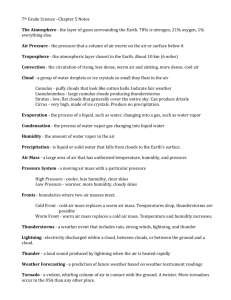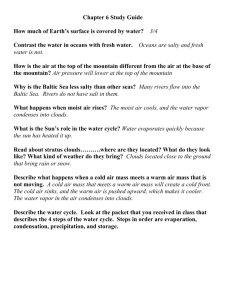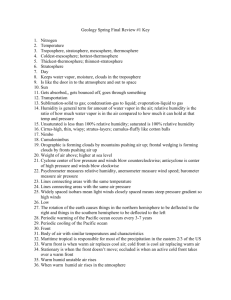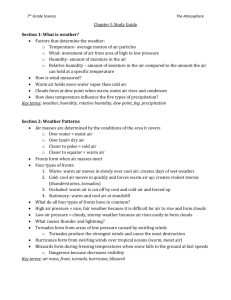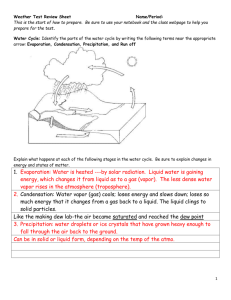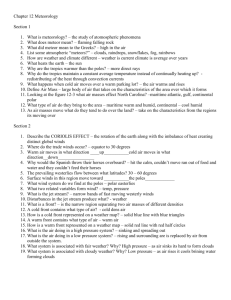What is Weather
advertisement
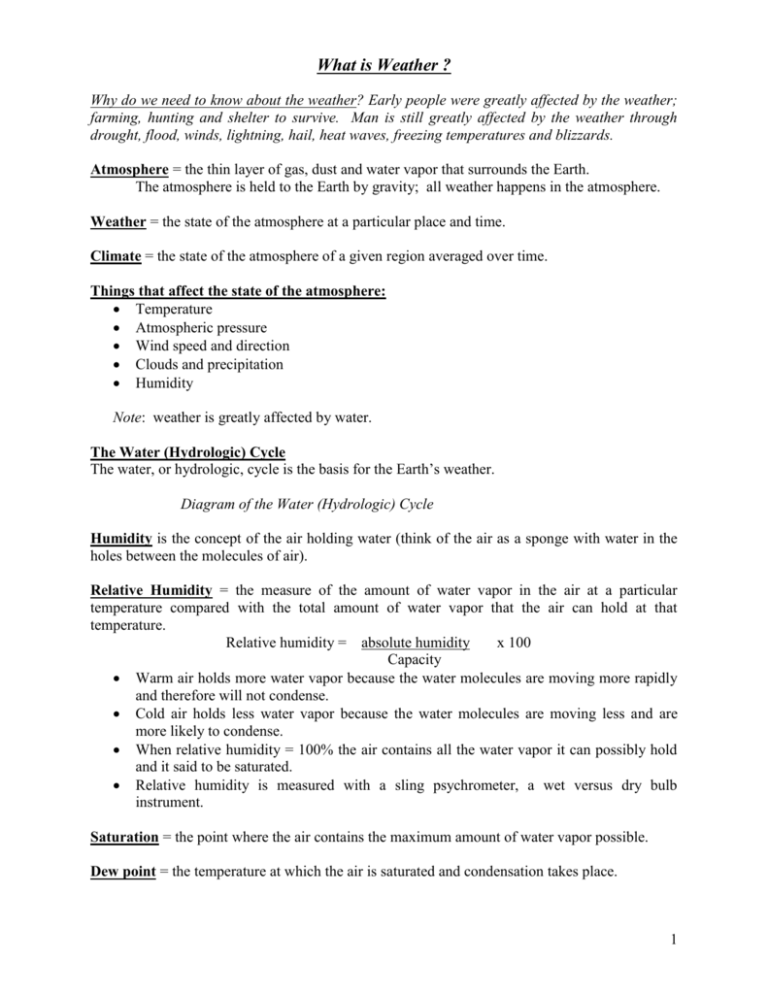
What is Weather ? Why do we need to know about the weather? Early people were greatly affected by the weather; farming, hunting and shelter to survive. Man is still greatly affected by the weather through drought, flood, winds, lightning, hail, heat waves, freezing temperatures and blizzards. Atmosphere = the thin layer of gas, dust and water vapor that surrounds the Earth. The atmosphere is held to the Earth by gravity; all weather happens in the atmosphere. Weather = the state of the atmosphere at a particular place and time. Climate = the state of the atmosphere of a given region averaged over time. Things that affect the state of the atmosphere: Temperature Atmospheric pressure Wind speed and direction Clouds and precipitation Humidity Note: weather is greatly affected by water. The Water (Hydrologic) Cycle The water, or hydrologic, cycle is the basis for the Earth’s weather. Diagram of the Water (Hydrologic) Cycle Humidity is the concept of the air holding water (think of the air as a sponge with water in the holes between the molecules of air). Relative Humidity = the measure of the amount of water vapor in the air at a particular temperature compared with the total amount of water vapor that the air can hold at that temperature. Relative humidity = absolute humidity x 100 Capacity Warm air holds more water vapor because the water molecules are moving more rapidly and therefore will not condense. Cold air holds less water vapor because the water molecules are moving less and are more likely to condense. When relative humidity = 100% the air contains all the water vapor it can possibly hold and it said to be saturated. Relative humidity is measured with a sling psychrometer, a wet versus dry bulb instrument. Saturation = the point where the air contains the maximum amount of water vapor possible. Dew point = the temperature at which the air is saturated and condensation takes place. 1 How Clouds Form Clouds form as humid air is cooled to the dew point. Condensing water vapor form tiny drops around dust particles in the atmosphere; these tiny drops are called droplets – they are so small that the slightest air movement keeps them from falling to the surface of the Earth. Millions of droplets together form a cloud. As droplets move the bump and collide into each other combining to form bigger droplets. Once the droplets reach between 0.05mm and 0.5mm they fall in the form of precipitation. Types of clouds Cirrus Clouds = very high, white, thin, whispy clouds that contain ice. Stratus Clouds = near the ground, gray, layers or sheet clouds that usually bring precipitation. Cumulus Clouds = large puffy, individual clouds that look like balls of cotton, usually fair weather clouds. What causes changes in the weather ? Air mass = a large body of air with properties that are determined by the part of the Earth’s surface that the air mass forms over. Examples: Forming over land = dry air mass compared to forming over water = moist air mass Forming over equator = warm air mass versus forming over the poles = cold air mass. Air masses move and swirl over the surface of the Earth in different directions and at different speeds and often bump into one another. Rain, thunderstorms, snow, tornadoes and all weather-related events can result when air masses meet. Front = the boundary formed as two air masses meet and collide. Types of Fronts Warm Front = forms when a warm air mass slides over a departing cold air mass. As warm air rises the temperature drops and rain or precipitation often forms. Cold Front = forms as a cold air mass overtakes and moves underneath a warm air mass. The warm air is forced upward rapidly and a cold front forms. Cold fronts usually bring violent weather. Stationary Front = occurs when a cold air mass meets a warm air mass and neither air mass moves. Precipitation sometimes forms between these two fronts. Occluded Front = forms when two cold air masses meet and force a warm air mass between them to rise completely off the ground. The weather in an occluded front is difficult to predict because there are three air masses involved. 2 Pressure Systems Differences in air pressure have a great affect on the weather. High air pressure usually means clear, fair weather. Low air pressure usually means clouds and rainy weather. Pressure = as particles move and collide they exert pressure; when particles are more densely packed together they exert high pressure, when they are less densely packed they exert less (low) pressure. How Pressure Systems Form High Pressure System Cold air is dense and it sinks As the air sinks it warms up Warm air holds more water vapor o The total amount of water vapor remains the same As the air warms the relative humidity decreases as droplets in the clouds evaporate A high pressure system usually means fair weather as the moisture in the air is evaporated so few clouds form. Diagram of high pressure system Low Pressure System (reverse of high pressure system is true) Warm air has low density and it rises (forced upwards by surrounding denser air) As the air rises it cools As the air cools the relative humidity increases – eventually reaching the dew point o At the dew point condensation takes place and clouds form Low pressure systems usually form along fronts where warm air and cold air meet Low pressure systems cause most of the weather in the US. A low pressure system leads to precipitation in the form of rain, snow, hail, sleet. Diagram of low pressure system Moving Fronts When we witness a change in the weather from day to day it is due to the movement of air masses. It is the movement and collision of air masses that causes the weather to change. 3 4 Severe Weather Thunderstorms Thunderstorms are formed by rapid upward movement of warm moist air. Thunderstorms can occur within a warm moist air mass Thunderstorms most often occur at cold fronts Thunderstorms account for the greatest number of weather-related fatalities in the US due to the flooding, lightning and tornadoes that can be associated with them. How thunderstorms form As warm moist air is forced upward it cools and the water vapor condenses forming cumulus clouds. (These clouds can be very tall – up to 10km high) As the drips fall they collide and combine to form larger drops The falling drops create a downward movement of air that spreads out as it hits the surface causing winds o If the winds accompanying a thunderstorm are greater than 54mph then forcasters classify it as a severe thunderstorm (these usually contain hail). Thunderstorm diagram How does hail form? Lightning (see notes on electricity for how lightning forms) Tornadoes Tornadoes are violent funnel-shaped storms with whirling winds that move in narrow paths over land. Tornadoes form from severe thunderstorms Tornado producing thunderstorms involve the rapid upward movement of warm moist air The upward moving air begins to rotate (why the rotation starts is still not understood) As the speed of the rotation increases more warm moist air is drawn into the low pressure at the center A funnel shaped cloud extends from the bottom of the cloud sometimes touching ground o As it touches ground it picks up dirt and debris that give it the characteristic dark gray, black color. Tornadoes are one of the most destructive types of storms. 5 Hurricanes Hurricanes are the largest storms that occur on Earth. Hurricanes are very large, swirling, low pressure systems that from over tropical waters (water temperature must be at least 80 degrees F). Hurricanes can last for days due to the constant supply of energy from the warm waters To be classified as a hurricane there must be sustained winds of greater than 74mph. o Greatest winds recorded are 236mph; Category 5 “Mitch” in Nov 1998= most deadly hurricane ever How hurricanes form Hurricanes form over warm tropical oceans where two opposing winds meet and begin to swirl A low pressure forms in the middle of the swirling winds and begins rotating Warm moist air is forced upwards in the center The dropping pressure in the center pulls more air toward the center creating increasing winds and lower pressure. This cycle of increasing strength continues as long as the storm remains over warm water. Hurricanes weaken as they hit land because there is no longer a supply of energy (from the warm water) available. Life-cycle of a hurricane = form first as a low pressure system, then grow into a tropical depression (<31mph winds), then grow into a tropical storm (32-74mph winds), then grow into a hurricane (>74mph winds). Out of the 10 tropical storms per year average, 6 will develop into hurricanes and 2 will strike the US. Hurricane diagram Hurricane path diagram 6
